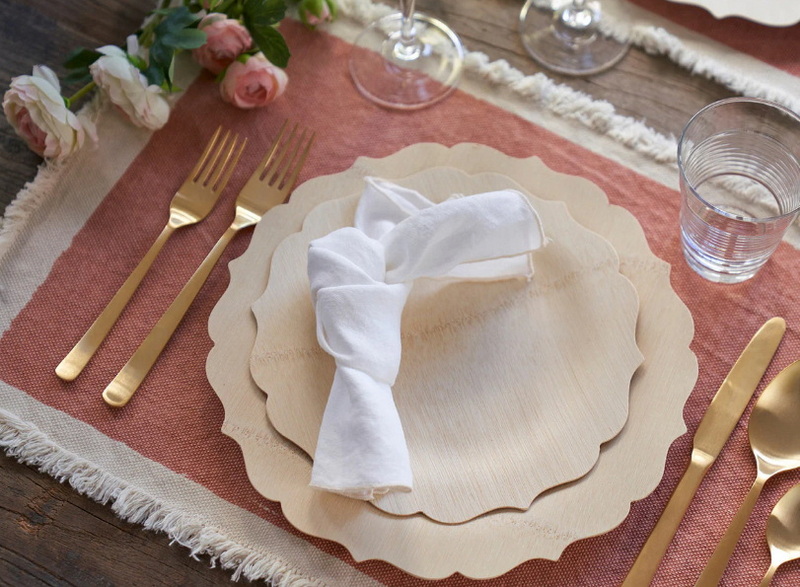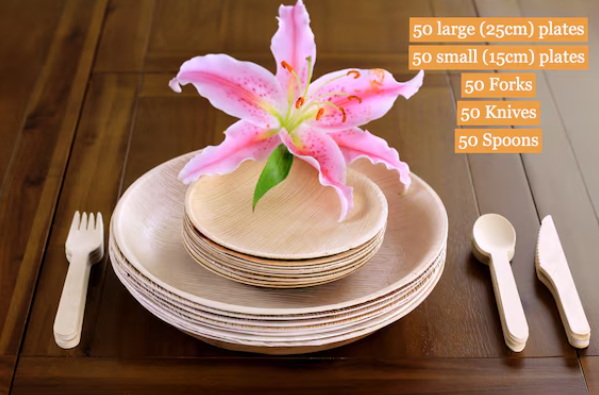
Content Menu
● Understanding Disposable Plates
>> Types of Eco-Friendly Disposable Plates
● Benefits of Using Eco-Friendly Disposable Plates
● Choosing the Right Disposable Plates for Your Wedding
● Real-Life Examples of Eco-Friendly Weddings
● Incorporating Sustainable Practices Beyond Plates
● Tips for a Sustainable Wedding
● Conclusion
● FAQs
>> 1. What are compostable plates made from?
>> 2. How long does it take for compostable plates to decompose?
>> 3. Are there stylish options available for disposable wedding plates?
>> 4. Can I use disposable plates for both indoor and outdoor weddings?
>> 5. How do I ensure my disposable plates are truly eco-friendly?
Planning a wedding involves numerous decisions, from the venue to the menu, and one of the most significant choices is the type of dinnerware you will use. As couples increasingly seek to make their special day more sustainable, the question arises: are wedding disposable plates eco-friendly? This article explores various types of disposable plates available for weddings, their environmental impact, and how they can contribute to a more sustainable celebration.

Understanding Disposable Plates
Disposable plates have become a popular choice for weddings due to their convenience and cost-effectiveness. However, not all disposable plates are created equal. Traditional plastic or Styrofoam plates can take hundreds of years to decompose and often end up in landfills, contributing to environmental pollution. In contrast, eco-friendly disposable plates are designed to break down naturally and are made from sustainable materials.
Types of Eco-Friendly Disposable Plates
- Bamboo Plates: Made from renewable bamboo, these plates are sturdy and biodegradable. They can hold various foods without leaking or breaking, making them a practical choice for any wedding menu. Bamboo is also a highly renewable resource, as it grows much faster than traditional wood.
- Bagasse Plates: Composed of sugarcane fiber, bagasse plates are 100% compostable and break down within months after disposal. They offer a similar sturdiness to traditional plates while being environmentally friendly. The production process of bagasse plates also utilizes waste materials from the sugarcane industry, reducing waste further.
- Palm Leaf Plates: Created from fallen palm leaves, these plates are natural, chemical-free, and biodegradable. They provide a rustic charm and can handle both hot and cold foods. The use of palm leaves reduces the need for additional land clearing or resource extraction.
- Recycled Paper Plates: While not as durable as other options, recycled paper plates are an affordable choice that minimizes waste by utilizing post-consumer materials. They are often made from recycled cardboard or paper pulp.
Benefits of Using Eco-Friendly Disposable Plates
1. Reduced Environmental Impact: By choosing compostable or biodegradable options, couples can significantly reduce the carbon footprint of their wedding. Unlike plastic plates that linger in landfills for centuries, eco-friendly plates return nutrients to the soil.
2. Convenience: Disposable plates eliminate the need for washing dishes after the event. This saves time and reduces stress on the wedding day.
3. Cost-Effective: Eco-friendly disposable plates often come at a fraction of the cost compared to renting traditional china. This allows couples to allocate their budget toward other important aspects of their wedding.
4. Variety of Designs: Many manufacturers offer stylish designs that can complement any wedding theme. From elegant bamboo options to rustic palm leaf designs, there is something for every aesthetic.
5. Guest Experience: Using eco-friendly plates can impress guests who appreciate sustainability efforts. It sets a positive tone for the event and reflects the couple's values.
Choosing the Right Disposable Plates for Your Wedding
When selecting disposable plates for your wedding, consider the following factors:
- Material: Opt for materials that are certified compostable or biodegradable.
- Design: Choose designs that align with your wedding theme while maintaining functionality.
- Size: Ensure you have an appropriate size for each course (appetizers, main courses, desserts).
- Supplier Certifications: Look for suppliers that provide certifications proving their products meet environmental standards.

Real-Life Examples of Eco-Friendly Weddings
Many couples have successfully integrated eco-friendly disposable plates into their weddings. For instance:
- Sarah and John's Rustic Wedding: They chose bagasse plates for their outdoor reception. Not only did these plates hold up beautifully against gourmet meals, but they also aligned with their love for nature. After the event, all plates were composted without leaving waste behind.
- Emily's Elegant Celebration: Emily opted for bamboo plates that complemented her elegant theme. Guests commented on how lovely the table settings looked while appreciating the sustainability aspect.
Incorporating Sustainable Practices Beyond Plates
While eco-friendly disposable plates are a great start, couples can further enhance their wedding's sustainability by incorporating other green practices:
- Local and Seasonal Foods: Choose a menu that features locally sourced and seasonal ingredients to reduce transportation emissions and support local farmers.
- Zero-Waste Decorations: Opt for decorations that can be reused or repurposed after the wedding, such as potted plants or fabric drapes.
- Energy-Efficient Lighting: Use LED lights or candles to illuminate the venue, reducing energy consumption.
- Car Pooling and Public Transport: Encourage guests to carpool or use public transport to minimize carbon emissions from travel.
Tips for a Sustainable Wedding
1. Start Early: Begin planning your sustainable wedding well in advance to ensure availability of eco-friendly products and services.
2. Communicate with Vendors: Clearly communicate your sustainability goals with vendors to ensure they understand your needs.
3. Educate Guests: Inform guests about your sustainability efforts and encourage them to participate by reducing waste and using public transport.
4. Set Realistic Goals: Be realistic about what you can achieve and focus on making a positive impact rather than striving for perfection.
5. Enjoy the Process: Remember to enjoy the planning process and celebrate your commitment to sustainability.
Conclusion
In conclusion, wedding disposable plates can indeed be eco-friendly if chosen wisely. By selecting compostable or biodegradable options made from materials like bamboo, bagasse, or palm leaves, couples can significantly reduce their environmental impact while enjoying the convenience of disposable dinnerware. This choice not only enhances the overall aesthetic of the wedding but also aligns with growing concerns about sustainability in event planning.

FAQs
1. What are compostable plates made from?
Compostable plates are typically made from natural materials such as bamboo, sugarcane (bagasse), or palm leaves.
2. How long does it take for compostable plates to decompose?
Compostable plates can break down within a few months under proper composting conditions.
3. Are there stylish options available for disposable wedding plates?
Yes! Many manufacturers offer elegant designs that cater to various wedding themes while ensuring sustainability.
4. Can I use disposable plates for both indoor and outdoor weddings?
Absolutely! Eco-friendly disposable plates are suitable for both indoor and outdoor settings and can withstand various food types.
5. How do I ensure my disposable plates are truly eco-friendly?
Look for certifications from recognized organizations like BPI (Biodegradable Products Institute) that verify the compostability of the products you choose.

















